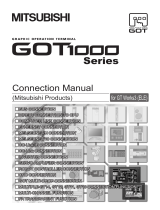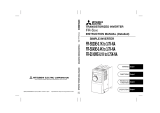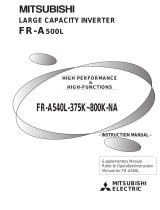Page is loading ...

A-1
Thank you for choosing this Mitsubishi Inverter control terminal
option.
This instruction manual gives handling information and
precautions for use of this equipment. Incorrect handling might
cause an unexpected fault. Before using the equipment, please
read this manual carefully to use the equipment to its optimum
performance.
Please forward this manual to the end user.
1. Electric Shock Prevention
This section is specifically about
safety matters
Do not attempt to install, operate, maintain or inspect this
product until you have read through this instruction manual
and appended documents carefully and can use the equipment
correctly. Do not use this product until you have a full
knowledge of the equipment, safety information and
instructions.
In this instruction manual, the safety instruction levels are
classified into "WARNING" and "CAUTION".
Assumes that incorrect handling may
cause hazardous conditions, resulting
in death or severe injury.
Assumes that incorrect handling may
cause hazardous conditions, resulting
in medium or slight injury, or may
cause physical damage only.
Note that even the level may lead to a serious
consequence according to conditions. Please follow the
instructions of both levels because they are important to
personnel safety.
WARNING
CAUTION
CAUTION
Safety Precautions
WARNING
• While power is on or when the inverter is running, do not
open the front cover. Otherwise, you may get an electric
shock.
• Do not run the inverter with the front cover or wiring cover
removed. Otherwise, you may access the exposed high-
voltage terminals and charging part and get an electric shock.
• If power is off, do not remove the front cover except for wiring
or periodic inspection. You may access the charged inverter
circuits and get an electric shock.
• Before starting wiring or inspection, check to make sure that
the indication of the inverter operation panel is off, wait for at
least 10 minutes after the power supply has been switched off,
and check that there are no residual voltage using a tester or
the like. The capacitor is charged with high voltage for some
time after power off and it is dangerous.
• Any person who is involved in the wiring or inspection of this
equipment should be fully competent to do the work.
• Always install the control terminal option before wiring.
Otherwise, you may get an electric shock or be injured.
• Do not touch the control terminal option with wet hands.
Otherwise, you may get an electric shock.
• Do not subject the cables to scratches, excessive stress,
heavy loads or pinching. Otherwise you may get an electric
shock.

A-2
2. Injury Prevention
3. Additional Instructions
Also note the following points to prevent an accidental failure,
injury, electric shock, etc.
(1) Transportation and mounting
(2) Trial run
(3) Usage
(4) Maintenance, inspection and parts replacement
(5) Disposal
(6) General instruction
CAUTION
• Apply only the voltage specified in the instruction manual to
each terminal. Otherwise, burst, damage, etc. may occur.
• Ensure that the cables are connected to the correct terminals.
Otherwise, burst, damage, etc. may occur.
• Always make sure that polarity is correct to prevent damage,
etc. Otherwise, burst, damage may occur.
• While power is on or for some time after power-off, do not touch
the inverter as they will be extremely hot. Doing so can cause
burns.
CAUTION
• Do not install or operate the terminal block option unit if it is
damaged or has parts missing.
• Do not stand or rest heavy objects on the product.
• Check that the mounting orientation is correct.
• Prevent other conductive bodies such as screws and metal
fragments or other flammable substance such as oil from
entering the inverter.
CAUTION
• Before starting operation, confirm and adjust the parameters.
A failure to do so may cause some machines to make
unexpected motions.
WARNING
• Do not modify the equipment.
• Do not perform parts removal which is not instructed in this
manual. Doing so may lead to fault or damage of the product.
CAUTION
• When parameter clear or all parameter clear is performed,
reset the required parameters before starting operations.
Each parameter returns to the initial value.
• For prevention of damage due to static electricity, touch
nearby metal before touching this product to eliminate static
electricity from your body.
CAUTION
• Do not test the equipment with a megger (measure insulation
resistance).
CAUTION
• Treat as industrial waste.
All illustrations given in this manual may have been drawn
with covers or safety guards removed to provide in-depth
description. Before starting operation of the product, always
return the covers and guards into original positions as
specified and operate the equipment in accordance with the
inverter manual.

I
⎯ CONTENTS ⎯
1 PRE-OPERATION INSTRUCTIONS 1
1.1 Unpacking and Product Confirmation .............................................................................................1
1.1.1 Packing Confirmation .....................................................................................................................................1
1.1.2 Parts ...............................................................................................................................................................2
1.1.3 Terminal layout ...............................................................................................................................................3
1.2 Terminal connection diagram...........................................................................................................4
1.3 Control terminal specifications ........................................................................................................6
1.4 Communication................................................................................................................................12
2 INSTALLATION 13
2.1 Pre-Installation Instructions ...........................................................................................................13
2.2 Installation procedure .....................................................................................................................14
3 WIRING 17
3.1 RS-485 terminals system configuration ........................................................................................17
3.2 Wiring method of RS-485 terminals ...............................................................................................19
3.3 Wiring................................................................................................................................................23
4 COMMUNICATION OPERATION FROM RS-485 TERMINALS 25
4.1 RS-485 communication related parameter ....................................................................................26

1
1
1 PRE-OPERATION INSTRUCTIONS
1.1 Unpacking and Product Confirmation
Take the control terminal option out of the package, check the product name on the reverse side, and
confirm that the product is as you ordered and intact.
This product is a control terminal option unit dedicated for the FR-E
700 series.
1.1.1 Packing Confirmation
Check the enclosed items.
Control terminal option
......................................................... 1
Instruction manual
.........................................................1
Control terminal change notice sticker
..............Two stickers (refer to page 16)
Instruction manual
+E7TR
+E7TR

2
PRE-OPERATION INSTRUCTIONS
1.1.2 Parts
OPENOPEN
100100
SOURCESOURCE
SINKSINK
V
II
Front view
OPEN
SOURCE
I
SINK
Rear view
V
Mounting
hole
OPEN
SOURCE
SINK
I
Connector
Connect to the inverter control circuit connector.
Control terminal option type
100
Terminal 2/SG switch
Set terminal 2/SG switch to the right position (ON) to pass a shielded wire across
terminal SG. As a result, terminal 2 changes to terminal SG.
(Note that analog input of terminal 2 is made invalid)
Voltage/current input switch
Either voltage input (0 to 5V, 0 to 10V) or current input (4 to 20mA) can be selected for
terminals 4 used for analog input.
Change the input specifications to change Pr. 267 and voltage/current input switch.
(Refer to the inverter manual for details.)
100
Terminating resistor switch
Factory-set to "OPEN".
Set only the terminating resistor switch of
the remotest inverter to the "100Ω"
position.
FR-E7TR
Control logic switchover jumper connector
Control logic (sink logic, source logic) can be switched.
The input signals are set to sink logic (SINK) when shipped from the
factory.
(Refer to the inverter manual for details.)
(Refer to page 20, 22)

3
PRE-OPERATION INSTRUCTIONS
1
1.1.3 Terminal layout
O
N
OPENOPEN
100100
SOURCESOURCE
SINKSINK
V
II
SE
SDA SDB RDA RDB SG 2
SDA
SDB RDA
RDB
SG
2
SDA SDB RDA RDB RUN FU
SDA
SDB RDA RDB
RUN
FU
SE
10
4
RM
RH
MRS
RES
SD
PC
STF
STR
SD SD
A
B
C
FM
RL

4
PRE-OPERATION INSTRUCTIONS
1.2 Terminal connection diagram
Terminal 4 input
(Current input)
SINK
OPEN
SDA
I
SOURCE
(+)
V
100Ω
(-)
Running
Frequency detection
Open collector output
FM
Open collector output common
SD
Sink/source common
+-
Indicator (Frequency meter, etc.)
FU
Moving-coil type
1mA full-scale
RUN
Calibration
resistor
SE
*5
Terminal functions vary with the
output terminal assignment (Pr.
190, Pr. 191)
SDA
SDB
SDB
RDA
RDA
RDB
RDB
From the computer
or previous inverter
To the next inverter
EIA-485 (RS-485)
communication signal
*7
Terminating
resistor switch
Output stop
Relay output
Relay output
(Alarm output)
A
B
C
Terminal functions vary by
Pr. 192 A,B,C terminal
function selection
Terminal
2/SG switch
Frequency setting signals (Analog)
0 to 5VDC
10(+5V)
2
2
3
1
4 4 to 20mADC
Frequency setting
potentiometer
1/2W1kΩ
SG
(Analog common)
*4
*2
*6
*3
O
N
*3
0 to 5VDC
(0 to 10VDC)
0 to 10VDC
Voltage/current
input switch
Forward rotation start
Reverse rotation start
Middle speed
High speed
Low speed
Reset
Control input signals (No voltage input allowed)
Contact input common
24VDC power supply
(Common for external power supply transistor)
STR
STF
RH
RM
RL
MRS
SD
PC
*1
Terminal functions
vary with the input
terminal assignment
(Pr. 178 to Pr. 184)
Multi-speed
selection
RES
24V

5
PRE-OPERATION INSTRUCTIONS
1
*1 When using terminals PC-SD as a 24VDC power supply, take care not to short across terminals PC-SD.
*2 Terminal input specifications can be changed by analog input specifications switchover (Pr. 73).
*3 Terminal input specifications can be changed by analog input specifications switchover (Pr. 267).
Set the voltage/current input switch in the "V" position to select voltage input (0 to 5V/0 to10V) and "I" (initial value)
to select current input (4 to 20mA).
*4 It is recommended to use 2W1kΩ when the frequency setting signal is changed frequently.
*5 It is not necessary when calibrating the indicator from the operation panel.
*6 Set the switch to the right (ON) position to pass a shielded wire across terminal SG.
*7 Set only the terminating resistor switch of the remotest inverter to the "100Ω" position.

6
PRE-OPERATION INSTRUCTIONS
1.3 Control terminal specifications
(1) RS-485 communication
Terminal
Symbol
Terminal Name Description
SDA
(2 points)
Inverter send+ Sending signal output terminal from the inverter.
SDB
(2 points)
Inverter send- Inverse sending signal output terminal from the inverter.
RDA
(2 points)
Inverter receive+
Receive signal input terminal of the inverter.
Changing the terminating resistor switch to "100Ω" side connects the inverter
to the 100Ω terminating resistor.
RDB
(2 points)
Inverter receive-
Receive signal input terminal of the inverter.
Changing the terminating resistor switch to "100Ω" side connects the inverter
to the 100Ω terminating resistor.
SG
RS-485 communication
common,
Analog common
Common terminal of RS-485 communication and frequency setting signal
(terminal 2 or terminal 4).
Do not earth (ground).

7
PRE-OPERATION INSTRUCTIONS
1
(2) Frequency setting
Terminal
Symbol
Terminal
Name
Description Rated Specifications
10
Frequency
setting power
supply
Used as power supply when connecting
potentiometer for frequency setting (speed setting)
from outside of the inverter.
5.2VDC ± 0.2V
Permissible load current 10mA
2
Frequency
setting
(voltage)/
Common
terminal
Inputting 0 to 5VDC (or 0 to 10V) provides the maximum
output frequency at 5V (10V) and makes input and
output proportional. Use
Pr. 73
to switch between input 0
to 5VDC (initial setting) and 0 to 10VDC input.
Set terminal 2/SG switch
(refer to page 2)
to the right
position (ON) to change terminal 2 to terminal SG to
pass a shielded wire across terminal SG during RS-485
communication.
In this case, voltage at terminal 2 is 0V input.
Voltage input:
Input resistance10k
Ω ±
1k
Ω
Permissible maximum voltage 20VDC
SG selection:
Common terminal
4
Frequency
setting
(current)
Inputting 4 to 20mADC (or 0 to 5V, 0 to 10V) provides
the maximum output frequency at 20mA and makes
input and output proportional. This input signal of
terminal 4 is valid only when the AU signal is on
(terminal 2 input is invalid). Use Pr. 267 to switch from
among input 4 to 20mA (initial setting), 0 to 5VDC and
0 to 10VDC. Set the voltage/current input switch in the
"V" position to select voltage input (0 to 5V/0 to 10V).
Current input:
Input resistance 233
Ω ±
5
Ω
Maximum permissible current 30mA.
Voltage input:
Input resistance10k
Ω ±
1k
Ω
Permissible maximum voltage 20VDC
* Refer to the inverter manual for details of Pr. 73 and Pr. 267.
Terminal SG
Terminal 2
(Initial status)
O
N
O
N
Voltage input
I
V
Current input
(Initial status)
I
V

8
PRE-OPERATION INSTRUCTIONS
(3) Contact input
Terminal
Symbol
Terminal Name Description Rated Specifications
STF* Forward rotation start
Turn on the STF signal
to start forward rotation
and turn it off to stop.
When the STF and STR
signals are turned on
simultaneously, the stop
command is given.
Input resistance 4.7kΩ
Voltage at opening
21 to 26VDC
When contacts are short-
circuited
4 to 6mADC
STR
* Reverse rotation start
Turn on the STR signal
to start reverse rotation
and turn it off to stop.
RH,RM,
RL
*
Multi-speed selection
Multi-speed can be selected according to the
combination of RH, RM and RL signals.
MRS* Output stop
Turn on the MRS signal (20ms or more) to stop the
inverter output.
Use to shut off the inverter output when stopping the
motor by electromagnetic brake.
RES
* Reset
Used to reset fault output provided when fault
occurs. Turn on the RES signal for more than 0.1s,
then turn it off.
By setting Pr. 75, reset can be set to enabled only at
an inverter alarm occurrence. Recover about 1s
after reset is cancelled.
Refer to the inverter manual for details of Pr. 75.
* Input signal functions can be selected using Pr.178 to Pr.184 (input terminal function selection).
Refer to the inverter manual for details of Pr. 178 to Pr.184 .

9
PRE-OPERATION INSTRUCTIONS
1
SD
Contact input common
(sink) (initial setting)
Common terminal for contact input terminal (sink
logic) and terminal FM.
—
External transistor
common
(source)
When connecting the transistor output (open
collector output), such as a programmable controller
(PLC), when source logic is selected, connect the
external power supply common for transistor output
to this terminal to prevent a malfunction caused by
undesirable currents.
24VDC power supply
common
Common output terminal for 24VDC 0.1A power
supply (PC terminal). Isolated from terminals SG
and SE.
PC
External transistor
common (sink)
(initial setting)
When connecting the transistor output (open
collector output), such as a programmable controller
(PLC), when sink logic is selected, connect the
external power supply common for transistor output
to this terminal to prevent a malfunction caused by
undesirable currents.
Power supply voltage
range 22 to 26VDC
Permissible load current
100mA
Contact input common
(source)
Common terminal for contact input terminal (source
logic)
24VDC power supply Can be used as 24VDC 0.1A power supply.
Terminal
Symbol
Terminal Name Description Rated Specifications

10
PRE-OPERATION INSTRUCTIONS
(4) Output signal
Type
Terminal
Symbol
Terminal Name Description Rated Specifications
Relay
A, B, C
*1
Relay output
(fault output)
1 changeover contact output indicates that the inverter protective
function has activated and the output stopped.
Alarm: discontinuity across B-C (continuity across A-C), Normal:
continuity across B-C (discontinuity across A-C)
Contact capacity:230VAC
0.3A
(power factor = 0.4)
30VDC 0.3A
Open collector
RUN
*1
Inverter running
Switched low when the inverter output frequency is equal to or
higher than the starting frequency (initial value 0.5Hz). Switched
high during stop or DC injection brake operation.
*2
Permissible load 24VDC
(27VDC maximum) 0.1A
(maximum voltage drop
when the signal is on 3.4V)
FU *1
Frequency
detection
Switched low when the inverter output frequency is equal to or
higher than the preset detected frequency and high when less
than the preset detected frequency.
*2
SE
Open collector
output common
Common terminal of terminal RUN and FU.
—
Pulse
FM For meter
Select one e.g. output frequency
from monitor items.
*3
The output signal is proportional
to the magnitude of the
corresponding monitoring item.
Output item:
Output frequency (initial
setting)
Permissible load current
1mA
1440 pulses/s at 60Hz
*1 Output signal function can be selected using Pr. 190 to Pr. 192 (output terminal function selection)
Refer to the inverter manual for details of Pr. 190 to Pr. 192.
*2 Low indicates that the open collector output transistor is on (conducts).
High indicates that the transistor is off (does not conduct).
*3 Not output during inverter reset.

11
PRE-OPERATION INSTRUCTIONS
1
CAUTION
⋅
Terminals SD, SG and SE are common terminals for I/O signal. (All common terminals are isolated from
each other.) Do not earth them.
Do not connect terminal SD-SG and terminal SE-SG.
⋅ Terminal SD is a common terminal for the contact input terminals (STF, STR, RH, RM, RL, MRS, RES) and
frequency output signal (FM). The open collector circuit is isolated from the internal control circuit by
photocoupler.
⋅ Terminal SG is a common terminal for the frequency setting signals (terminal 2 or 4) and RS-485
communication. It should be protected from external noise using a shielded or twisted cable.
⋅ Terminal SE is a common terminal for the open collector output terminal (RUN, FU). The contact input
circuit is isolated from the internal control circuit by photocoupler.

12
PRE-OPERATION INSTRUCTIONS
1.4 Communication
Item Description
Communication protocol Mitsubishi inverter protocol (computer link communication), Modbus-RTU protocol
Conforming standard EIA-485 (RS-485)
Number of connectable
devices
32 units maximum
Communication speed 4800/9600/19200/38400bps
Communication method Half-duplex system, full-duplex system
Terminating resistor 100
Ω (valid/invalid can be changed with a terminating resistor switch)

13
2
2 INSTALLATION
2.1 Pre-Installation Instructions
Make sure that the input power of the inverter is off.
CAUTION
Do not install or remove a control terminal option with the input power supply is on.
Otherwise, the inverter and option may be damaged.

14
INSTALLATION
2.2 Installation procedure
(1) Remove the inverter front cover.
(Refer to the inverter instruction manual for removing the front cover.)
(2) Remove the installation screws of the standard control circuit terminal.
Pull the control circuit terminal downward.
Installation screw

15
2
INSTALLATION
(3) Using care not to bend the pins of the inverter's control circuit connector, reinstall the control terminal
option and fix it with the mounting screws.
(Tightening torque 0.56N⋅m to 0.75N⋅m)
Installation screw

16
INSTALLATION
(4) Install the inverter front cover.
(Refer to the inverter instruction manual for installing the front cover.)
Attatch a supplied control terminal change notice sticker to the next to the model name on the front
cover so that the control terminal has been replaced with the FR-E7TR. (Two control terminal change
notice sitckers are supplied and one of them is an extra.)
MITSUBISHI
+E7TR
Control terminal
change notice sticke
r
/







